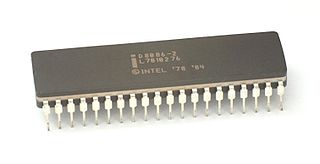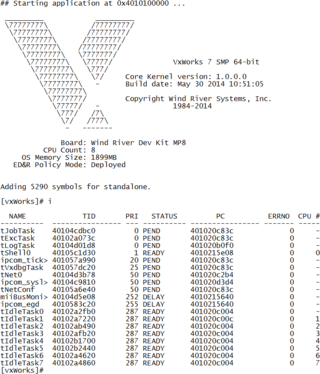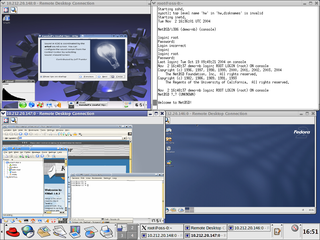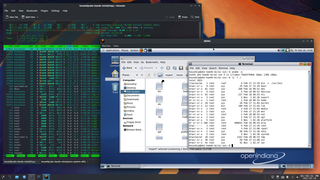Related Research Articles

The Intel 386, originally released as 80386 and later renamed i386, is a 32-bit microprocessor introduced in 1985. The first versions had 275,000 transistors and were the central processing unit (CPU) of many workstations and high-end personal computers of the time.
MIPS is a family of reduced instruction set computer (RISC) instruction set architectures (ISA) developed by MIPS Computer Systems, now MIPS Technologies, based in the United States.

x86 is a family of complex instruction set computer (CISC) instruction set architectures initially developed by Intel based on the Intel 8086 microprocessor and its 8088 variant. The 8086 was introduced in 1978 as a fully 16-bit extension of Intel's 8-bit 8080 microprocessor, with memory segmentation as a solution for addressing more memory than can be covered by a plain 16-bit address. The term "x86" came into being because the names of several successors to Intel's 8086 processor end in "86", including the 80186, 80286, 80386 and 80486 processors. Colloquially, their names were "186", "286", "386" and "486".
IA-64 is the instruction set architecture (ISA) of the discontinued Itanium family of 64-bit Intel microprocessors. The basic ISA specification originated at Hewlett-Packard (HP), and was subsequently implemented by Intel in collaboration with HP. The first Itanium processor, codenamed Merced, was released in 2001.
In computer architecture, 64-bit integers, memory addresses, or other data units are those that are 64 bits wide. Also, 64-bit central processing units (CPU) and arithmetic logic units (ALU) are those that are based on processor registers, address buses, or data buses of that size. A computer that uses such a processor is a 64-bit computer.

VxWorks is a real-time operating system developed as proprietary software by Wind River Systems, a subsidiary of Aptiv. First released in 1987, VxWorks is designed for use in embedded systems requiring real-time, deterministic performance and, in many cases, safety and security certification for industries such as aerospace, defense, medical devices, industrial equipment, robotics, energy, transportation, network infrastructure, automotive, and consumer electronics.

x86-64 is a 64-bit version of the x86 instruction set, first announced in 1999. It introduced two new modes of operation, 64-bit mode and compatibility mode, along with a new 4-level paging mode.
SPIM is a MIPS processor simulator, designed to run assembly language code for this architecture. The program simulates R2000 and R3000 processors, and was written by James R. Larus while a professor at the University of Wisconsin–Madison. The MIPS machine language is often taught in college-level assembly courses, especially those using the textbook Computer Organization and Design: The Hardware/Software Interface by David A. Patterson and John L. Hennessy (ISBN 1-55860-428-6).
In computing, Physical Address Extension (PAE), sometimes referred to as Page Address Extension, is a memory management feature for the x86 architecture. PAE was first introduced by Intel in the Pentium Pro, and later by AMD in the Athlon processor. It defines a page table hierarchy of three levels (instead of two), with table entries of 64 bits each instead of 32, allowing these CPUs to directly access a physical address space larger than 4 gigabytes (232 bytes).

Xen is a free and open-source type-1 hypervisor, providing services that allow multiple computer operating systems to execute on the same computer hardware concurrently. It was originally developed by the University of Cambridge Computer Laboratory and is now being developed by the Linux Foundation with support from Intel, Citrix, Arm Ltd, Huawei, AWS, Alibaba Cloud, AMD, Bitdefender and epam.
x86 virtualization is the use of hardware-assisted virtualization capabilities on an x86/x86-64 CPU.
A hypervisor is a type of computer software, firmware or hardware that creates and runs virtual machines. A computer on which a hypervisor runs one or more virtual machines is called a host machine, and each virtual machine is called a guest machine. The hypervisor presents the guest operating systems with a virtual operating platform and manages the execution of the guest operating systems. Unlike an emulator, the guest executes most instructions on the native hardware. Multiple instances of a variety of operating systems may share the virtualized hardware resources: for example, Linux, Windows, and macOS instances can all run on a single physical x86 machine. This contrasts with operating-system–level virtualization, where all instances must share a single kernel, though the guest operating systems can differ in user space, such as different Linux distributions with the same kernel.

QEMU is a free and open-source emulator. It emulates a computer's processor through dynamic binary translation and provides a set of different hardware and device models for the machine, enabling it to run a variety of guest operating systems. It can interoperate with Kernel-based Virtual Machine (KVM) to run virtual machines at near-native speed. QEMU can also do emulation for user-level processes, allowing applications compiled for one architecture to run on another.
Virtutech was a company founded in 1998 as a spin-off from the Swedish Institute of Computer Science (SICS), to commercially develop its Simics computer architecture simulator software. In 2004, Virtutech accepted investment and moved headquarters to San Jose, California, USA. In 2010, Virtutech was wholly acquired by Intel and became part of Intel's Wind River subsidiary. In 2018, Wind River was sold to TPG Capital, which continues to sell Simics under the Wind River brand. The Intel Stockholm site remains the center of Simics core R&D.
In computer security, executable-space protection marks memory regions as non-executable, such that an attempt to execute machine code in these regions will cause an exception. It makes use of hardware features such as the NX bit, or in some cases software emulation of those features. However, technologies that emulate or supply an NX bit will usually impose a measurable overhead while using a hardware-supplied NX bit imposes no measurable overhead.
In computing, hardware-assisted virtualization is a platform virtualization approach that enables efficient full virtualization using help from hardware capabilities, primarily from the host processors. A full virtualization is used to emulate a complete hardware environment, or virtual machine, in which an unmodified guest operating system effectively executes in complete isolation. Hardware-assisted virtualization was added to x86 processors in 2005, 2006 and 2010 (respectively).
The following is a timeline of virtualization development. In computing, virtualization is the use of a computer to simulate another computer. Through virtualization, a host simulates a guest by exposing virtual hardware devices, which may be done through software or by allowing access to a physical device connected to the machine.
SimOS was a full system simulator, developed in the Stanford University in the late nineties in the research group of Mendel Rosenblum. It was enabled to run IRIX 5.3 on MIPS, and Unix variants on Alpha.
OVPsim is a multiprocessor platform emulator used to run unchanged production binaries of the target hardware. It has public APIs allowing users to create their own processor, peripheral and platform models. Various models are available as open source. OVPsim is a key component of the Open Virtual Platforms initiative (OVP), an organization created to promote the use of open virtual platforms for embedded software development. OVPsim requires OVP registration to download.
References
- ↑ "Simics® Simulator". Intel. 2021-05-14. Retrieved 2022-02-02.
- ↑ "Simics used to port an OS". NetBSD Wiki. NetBSD.
- ↑ Engblom, Jakob (March 17, 2020). "Simics 6 at the Mountain Top". Intel Developer Zone.
- ↑ Engblom, Jakob (September 10, 2019). "Seeing the Early Snow on the Ridge". Intel Developer Zone Blog.
- ↑ Evoy, Sean (November 5, 2019). "Simics: Just when you thought it couldn't get any better". Wind River Blog.
- ↑ Engblom, Jakob (June 30, 2015). "Simics 5 is here - More Parallel than Ever". Wind River Blog.
- ↑ Engblom, Jakob (2017-10-01). "Back to Reverse Execution - Tools, Testing, & Virtual Systems". Archived from the original on 2017-10-01. Retrieved 2022-02-02.